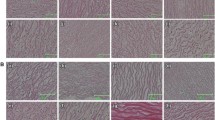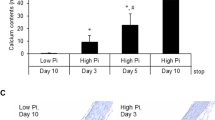Abstract
Objectives
Calcification is one of the major postoperative problems after aortic allograft implantation. We hypothesized that phosphate binders, lanthanum carbonate and calcium carbonate inhibit calcification of implanted aortic allografts and verified this hypothesis using a rat model.
Methods
Aortas were harvested from 4-week-old Brown Norway rats and implanted into the subdermal space of 4-week-old Lewis rats. Twenty-seven recipient Lewis rats were divided into Group N, Group L, and Group C (9 rats per group), which were fed a normal diet, a normal diet containing 3% lanthanum carbonate, and a normal diet containing 3% calcium carbonate, respectively. Implanted aortic allografts were explanted 2 weeks later. Calcification of aortic allografts was evaluated using von Kossa staining and calcium content assay. Calcification score was defined in von Kossa staining as 0 (none), 1 (mild), 2 (moderate), and 3 (severe). Serum calcium and phosphorus levels at euthanasia were measured.
Results
Calcification scores were 2.6, 1.2, and 0.8, and calcium content was 48.9, 15.8, and 8.9 mg/dry·g, in Groups N, L, and C, respectively. Calcification was significantly reduced in Groups L and C. Serum calcium level was 11.5, 12.2, and 13.5 mg/dl, and serum phosphorus level was 15.4, 12.5, and 11.7 mg/dl, in Groups N, L, and C, respectively. Serum calcium level in Group C was significantly higher than in the other two groups.
Conclusions
Lanthanum carbonate and calcium carbonate significantly reduced calcification of implanted aortic allografts in young rats. Although calcium carbonate induced hypercalcemia, lanthanum carbonate has significant potential to inhibit calcification of implanted aortic allografts.





Similar content being viewed by others
References
Yap CH, Yii M. Allograft aortic valve replacement in the adult: a review. Heart Lung Circ. 2004;13:41–51.
Saito A, Motomura N, Kakimi K, Narui K, Noguchi N, Sasatsu M, et al. Vascular allografts are resistant to methicillin-resistant Staphylococcus aureus through indoleamine 2,3-dioxygenase in a murine model. J Thorac Cardiovasc Surg. 2008;136:159–67.
Dossche K, Brutel Riviere de la A, Morshuis W, Schepens M, Ernst J. Aortic root replacement with human tissue valves in aortic valve endocarditis. Eur J Cardiothorac Surg. 1997;12:47–55.
Motomura N, Takamoto S, Murakawa T, Yoneda N, Shibusawa S, Maeda K, et al. Short-term result of aortic valve replacement with cryopreserved homograft valve in the University of Tokyo Tissue Bank. Artif Org. 2002;26:449–52.
Kitamura T, Morota T, Motomura N, Ono M, Shibata K, Ueno K, et al. Management of infected grafts and aneurysms of the aorta. Ann Vasc Surg. 2005;19:335–42.
Fontan F, Choussat A, Deville C, Doutremepuich C, Coupillaud J, Vosa C. Aortic valve homografts in the surgical treatment of complex cardiac malformations. J Thorac Cardiovasc Surg. 1984;87:649–57.
O’Brien MF, Harrocks S, Stafford EG, Gardner MA, Pohlner PG, Tesar PJ, et al. The homograft aortic valve: a 29-year, 99.3% follow up of 1022 valve replacements. J Heart Valve Dis. 2001;10:334–44. discussion 335.
Tweddell JS, Pelech AN, Frommelt PC, Mussatto KA, Wyman JD, Fedderly RT, et al. Factors affecting longevity of homograft valves used in right ventricular outflow tract reconstruction for congenital heart disease. Circulation. 2000;102:III130–135.
Clarke DR, Campbell DN, Hayward AR, Bishop DA. Degeneration of aortic valve allografts in young recipients. J Thorac Cardiovasc Surg. 1993;105:934–41. discussion 941–932.
Yankah AC, Alexi-Meskhishvili V, Weng Y, Schorn K, Lange PE, Hetzer R. Accelerated degeneration of allografts in the first two years of life. Ann Thorac Surg. 1995;60:71–6. discussion 576–577.
Mitchell RN, Jonas RA, Schoen FJ. Pathology of explanted cryopreserved allograft heart valves: comparison with aortic valves from orthotopic heart transplants. J Thorac Cardiovasc Surg. 1998;115:118–27.
Yamauchi H, Motomura N, Chung UI, Sata M, Takai D, Saito A, et al. Growth-associated hyperphosphatemia in young recipients accelerates aortic allograft calcification in a rat model. J Thorac Cardiovasc Surg. 2013;145:522–30.
Giachelli CM. The emerging role of phosphate in vascular calcification. Kidney Int. 2009;75:890–7.
Woda CB, Halaihel N, Wilson PV, Haramati A, Levi M, Mulroney SE. Regulation of renal NaPi-2 expression and tubular phosphate reabsorption by growth hormone in the juvenile rat. Am J Physiol Renal Physiol. 2004;287:F117–23.
Block GA, Hulbert-Shearon TE, Levin NW, Port FK. Association of serum phosphorus and calcium x phosphate product with mortality risk in chronic hemodialysis patients: a national study. Am J Kidney Dis. 1998;31:607–17.
Webb CL, Nguyen NM, Schoen FJ, Levy RJ. Calcification of allograft aortic wall in a rat subdermal model. Pathophysiology and inhibition by Al3 + and aminodiphosphonate preincubations. Am J Pathol. 1992;141:487–96.
Shigematsu T. Lanthanum carbonate effectively controls serum phosphate without affecting serum calcium levels in patients undergoing hemodialysis. Ther Apher Dial. 2008;12:55–61.
Ben-Dov IZ, Pappo O, Sklair-Levy M, Galitzer H, Ilan Y, Naveh-Many T, et al. Lanthanum carbonate decreases PTH gene expression with no hepatotoxicity in uraemic rats. Nephrol Dial Transplant. 2007;22:362–8.
O’Neill WC. The fallacy of the calcium-phosphorus product. Kidney Int. 2007;72:792–6.
Foley RN, Collins AJ, Ishani A, Kalra PA. Calcium-phosphate levels and cardiovascular disease in community-dwelling adults: the Atherosclerosis Risk in Communities (ARIC) Study. Am Heart J. 2008;156:556–63.
Slatopolsky E, Weerts C, Stokes T, Windus D, Delmez J. Alternative phosphate binders in dialysis patients: calcium carbonate. Semin Nephrol. 1986;6:35–41.
Damment SJ, Pennick M. Clinical pharmacokinetics of the phosphate binder lanthanum carbonate. Clin Pharmacokinet. 2008;47:553–63.
Pennick M, Dennis K, Damment SJ. Absolute bioavailability and disposition of lanthanum in healthy human subjects administered lanthanum carbonate. J Clin Pharmacol. 2006;46:738–46.
Damment SJ, Pennick M. Systemic lanthanum is excreted in the bile of rats. Toxicol Lett. 2007;171:69–77.
Hutchison AJ, Barnett ME, Krause R, Siami GA. Lanthanum carbonate treatment, for up to 6 years, is not associated with adverse effects on the liver in patients with chronic kidney disease Stage 5 receiving hemodialysis. Clin Nephrol. 2009;71:286–95.
Wills MR, Savory J. Aluminium poisoning: dialysis encephalopathy, osteomalacia, and anaemia. Lancet. 1983;2:29–34.
Altmann P, Barnett ME, Finn WF. Cognitive function in Stage 5 chronic kidney disease patients on hemodialysis: no adverse effects of lanthanum carbonate compared with standard phosphate-binder therapy. Kidney Int. 2007;71:252–9.
D’Haese PC, Spasovski GB, Sikole A, Hutchison A, Freemont TJ, Sulkova S, et al., A multicenter study on the effects of lanthanum carbonate (Fosrenol) and calcium carbonate on renal bone disease in dialysis patients. Kidney Int. 2003: S73–S78.
Behets GJ, Dams G, Vercauteren SR, Damment SJ, Bouillon R, De Broe ME, et al. Does the phosphate binder lanthanum carbonate affect bone in rats with chronic renal failure? J Am Soc Nephrol. 2004;15:2219–28.
Feng L, Xiao H, He X, Li Z, Li F, Liu N, et al. Neurotoxicological consequence of long-term exposure to lanthanum. Toxicol Lett. 2006;165:112–20.
Acknowledgements
This study was supported by the Japan Society for the Promotion of Science KAKENHI Grant number JP23592028.
Author information
Authors and Affiliations
Corresponding author
Ethics declarations
Conflict of interest
The authors have declared that no conflict of interest exists.
Rights and permissions
About this article
Cite this article
Kinoshita, O., Yamauchi, H., Motomura, N. et al. Lanthanum carbonate, a phosphate binder, inhibits calcification of implanted aortic allografts in a rat model. Gen Thorac Cardiovasc Surg 67, 413–419 (2019). https://doi.org/10.1007/s11748-018-1026-7
Received:
Accepted:
Published:
Issue Date:
DOI: https://doi.org/10.1007/s11748-018-1026-7




